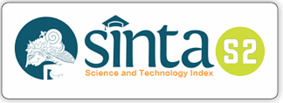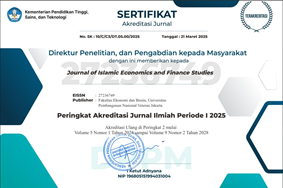Analisis Valuasi Harga Saham Healthcare Menggunakan Price to Earnings Ratio (PER) pada Saham Syariah
DOI:
https://doi.org/10.47700/jiefes.v3i2.5057Keywords:
Investasi, PER, Saham Syariah, Saham, Valuasi Harga SahamAbstract
An Investor can potentially expose to a risk of loss in an investment when the capital was invested with no knowledge-based decision theory. This can be avoided by analyzing the stock price valuation. The purpose of this study is to examine investor decision-making in Islamic stocks using the Price to Earnings Ratio to analyze the valuation of stock price. This study uses a quantitative approach by collecting secondary data from the Indonesian Stock Exchange in the form of financial statements or company annual reports of healthcare shares from 2018 to 2021. The technique of descriptive statistics is used in this research. The finding of this study indicates that, based on the PER method analysis, there is an inconsequential market value in the stock price for the shares of PT Kalbe Farma Tbk (KLBF), PT Kimia Farma Tbk (KAEF), and PT Mitra Keluarga Karya Sehat Tbk (MIKA) thus, the investors suggested to sell. On the contrary, the investor should buy the shares of PT Industri Jamu Dan Pharmacy Sido Muncul Tbk (SIDO), since the company’s ratios of ROE, DPS, and DPR are the highest among the three other companies, followed by a lower persistence rate of PER value.Risiko kerugian dalam berinvestasi dapat terjadi pada seorang investor jika pengambilan keputusan investasi tanpa didasari oleh pengetahun sehingga menimbulkan kerugian terhadap modal. Upaya untuk mengurangi kerugian dapat diatasi dengan menganalisis valuasi harga saham. Tujuan penelitian ini adalah untuk menganalisis pengambilan keputusan investor dalam mempertimbangkan investasi pada saham syariah melalui metode Price to Earnings Ratio (PER) terhadap valuasi harga saham. Penelitian ini menggunakan metode kuantitatif dengan teknik stastistik deskriptif. Data yang digunakan adalah data sekunder berupa laporan keuangan atau laporan perusahaan sektor healthcare per tahun yang diakses dari laman website Bursa Efek Indonesia. Dari hasil penelitian melalui metode PER terhadap nilai fundamental perusahaan dan valuasi harga saham pada perusahaan sektor healthcare di indeks JII70 periode 2018-2021 ditemukan bahwa saham PT Kalbe Farma Tbk (KLBF), PT Kimia Farma Tbk (KAEF), dan PT Mitra Keluarga Karyasehat Tbk (MIKA) menunjukkan pertumbuhan yang kurang baik, sehingga investor dianjurkan menjualnya. Sebaliknya, investor dianjurkan membeli saham PT Industri Jamu Dan Farmasi Sido Muncul Tbk (SIDO), yang memiliki rasio ROE, DPS, dan DPR tertinggi dibandingkan tiga perusahaan lainnya dan nilai PER terendah terhadap perusahaan yang lain.
References
Alhakim, G. F. (2018). Analisis Fundamental Perusahaan Serta Penilaian Saham Dengan Metode Price Earning Ratio dan Price Book Value Dalam Rangka Menilai Harga Wajar Saham Dan Keputusan Investasi (Studi PadaPerusahaan Konstruksi yang Terdaftar di Daftar Efek Syariah (DES) Periode 2015-2017). (S1 Skripsi), UIN Raden Intan Lampung, Lampung.
Arfa, A., & Efriadi, B. (2022). Analisis Fundamental terhadap Saham Syariah dalam Memutuskan Berinvestasi di Saham yang Listing di Indeks Saham Syariah Indonesia Al-Muqayyad, 5(1), 42-59. doi:https://doi.org/10.46963/jam.v5i1.568
Burhanuddin, S. (2008). Pasar Modal Syariah (Tinjauan Hukum). Yogyakarta: UII Press.
Darmadji, F. (2012). Pasar Modal di Indonesia. Jakarta: Salemba Empat.
Hanafi, M. M., Husnan, S., Tandelilin, E., & Taswan. (2012). Bank Risk and Market Discipline. Journal of Indonesian Economy & Business, 27(3).
Hartono, S. B., & Ristianawati, Y. (2022). Kinerja Keuangan Syariah Dalam Memproksi Harga Saham Di ISSI. ISOQUANT: Jurnal Ekonomi, Manajemen dan Akuntansi, 6(1). doi:https://doi.org/10.24269/iso.v6i1.834.g574
Huda, N., & Nasution, M. E. (2007). Investasi Pada Pasar Modal Syariah. Jakarta: Kencana.
Husnan, S. (2015). Dasar-dasar Teori Portfolio dan Analisis. Yogyakarta: UPP STIM.
Indonesia, B. E. (2021). Indeks Saham Syariah. https://idx.co.id/idx-syariah/indeks-saham-syariah
Kosasih, D. T. (2021). Melihat Potensi Saham Sektor Kesehatan hingga Akhir 2021. https://m.liputan6.com/saham/read/4698321/melihatpotensi-saham-sektor-kesehatan-hingga-akhir-2021,
Manan, A. (2012). Hukum Ekonomi Syariah Dalam Perspektif Kewenangan Peradilan Agama. Jakarta: Kencana.
Mysharing. (2022). Mengenal Daftar Efek Syariah (DES). https://www.google.com/amp/s/keuangansyariah.mysharing.co/mengenal-daftar-efek-syariah-des/%3famp=1
Narbuko, C., & Achmadi, A. (2016). Metodologi Penelitian. Jakarta: PT Bumi Aksara.
Nonie, A., Isnaini, D., & Oktarina, A. (2019). Lembaga Keuangan Syariah. Bengkulu: CV. Zigie Utama.
Nurhaliza, S. (2022). Mengenal Valuasi Saham Milenial, Yuk Simak Penjelasannya. https://idx.co.id/idx-syariah/indeks-saham-syariah
Putri, D. H., Hidayat, R. R., & Wi Endang, M. G. (2016). Penggunaan Analisis Fundamental Dengan Pendekatan PER Untuk Menilai Kewajaran Harga Saham dan Pengambilan Keputusan Invetasi. Jurnal Administrasi Bisnis, 26(1).
Riyanto, Oky Slamet, S., & Rahayu, S. M. (2014). Penerapan Metode Diskonto Dividen dengan Model Pertumbuhan Konstan dan Metode Price Earning Ratio (PER) untuk Menilai Kewajaran Harga Saham Sebagai Dasar Pengambilan Keputusan Investasi. Jurnal Administrasi Bisnis, 9(2).
Santyaningtyas, A. C., & Wildana, D. T. (2019). Investasi Syariah. Jember: UPT Percetakan & Penerbitan Universitas Jember.
Tandelilin, E. (2001). Analisis Investasi dan Manajemen Portfolio. Yogyakarta: BPFE.
Zakiah, D. (2014). Penerapan Analisis Fundamental untuk Penilaian Kewajaran Harga Saham dan Keputusan Investasi dengan Metode Price Earning Ratio (PER). Jurnal Administrasi Bisnis, 9(2).
Downloads
Published
Issue
Section
License
Authors who publish with this journal agree to the following terms:
- Authors retain copyright and grant the journal right of first publication with the work simultaneously licensed under a Creative Commons Attribution 4.0 International License that allows others to share the work with an acknowledgment of the work's authorship and initial publication in this journal.
- Authors can enter into separate, additional contractual arrangements for the non-exclusive distribution of the journal's published version of the work (e.g., post it to an institutional repository or publish it in a book), with an acknowledgment of its initial publication in this journal.
- Authors are permitted and encouraged to post their work online (e.g., in institutional repositories or on their website) before and during the submission process, as it can lead to productive exchanges, as well as earlier and greater citation of published work.

This work is licensed under a Creative Commons Attribution 4.0 International License.











